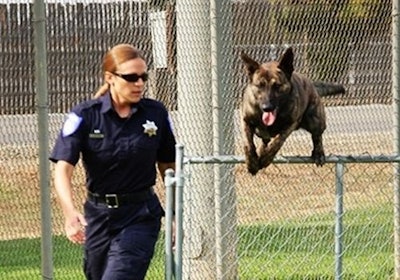 Officer Linda Matthew is the Sacramento (Calif.) Police Department’s first female K-9 handler. Photo: Sacramento (Calif.) PD
Officer Linda Matthew is the Sacramento (Calif.) Police Department’s first female K-9 handler. Photo: Sacramento (Calif.) PD
Have you noticed there are more female K-9 handlers in the private sector than in law enforcement? In fact, I found there are very few female K-9 handlers in law enforcement overall. In this first unit-specific installment of my series on joining special details, I’ll take a look at just why this is, and provide tips for how to become one of the few to hold this position.
At first it seemed the low representation of female K-9 handlers in law enforcement was due to the time commitment. The initial training is long -- between three and eight weeks -- and usually takes place out of town. Add in continuing maintenance, refresher training, and daily care, and there is little relief. With the exception of large agencies, K-9 officers are on call 24/7 and rarely work the day shift. The officer’s family must also be taken into consideration because once a dog and officer team up there is little, if any, separation between work and family.
But it turns out the truth is simply there are fewer female officers to begin with, and K-9 positions are very competitive and limited in number. No matter how many officers apply for a K-9 position, odds are there will be more males than females applying. It seems the reason for fewer female K-9 officers is a numbers issue. So don’t allow the numbers to deter you.
If you’re motivated to join a K-9 unit, use these five tips to prepare and achieve your goal.
1. Know what is required to apply for your agency’s K-9 Unit.
Begin with looking up the requirements in your policy and procedure manual. Most agencies require between 3 and 5 years of patrol experience. There is often no “pre-test” or formal training. Practical experience handling K-9s is not imperative, but certainly beneficial. A physical fitness test is required at some agencies.
I found preferred qualifications included aggressive officer who works on his/her own with little or no supervision and is capable of handling stress while making quick sound decisions, good report writing and record keeping skills, and able to communicate his/her evidence accurately in court. I also found mention of an officer who is personable and comfortable speaking to a crowd. (K-9 officers have a unique opportunity for public relations.)
2. Complete some basic research.
Research the difference in patrol, detection, and dual purpose dogs. Know the different breeds, their temperament, how they work, and how they are different. Does your department use dual purpose dogs? Learn and understand what training is required.
3. Get online.
Check with your agency’s K-9 Unit and find out what company they use for their certification. These facilities usually maintain Websites that provide a lot of information about them. Contact the training facility and talk to the trainers.
Follow or join the various police dog associations. These associations not only offer information online and in publications, they offer seminars to their members. (You do not have to be a handler to be a member.) You will find numerous professional sites by simply entering “K9 Officer” in any online search engine.
4. Talk to and get to know officers already in the unit.
Follow up by talking with and riding with someone in a K-9 Unit. Volunteer to assist present K9 handlers in the various training profiles including a canine decoy can be a valuable asset to have when applying for a position.
5. Read, Ask, Review, and Read some more.
Whether your information is obtained from law enforcement publications, books, online articles, trainers, or officers, the more knowledge you build up prior to applying for the position the better.
Related:




















